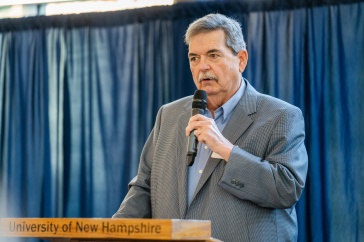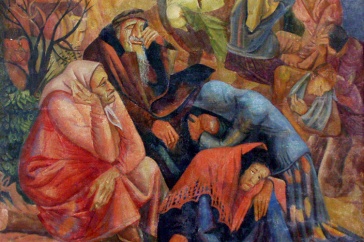
Valenza, second from left, with students in his Hewitt Hall woodshop, 1962. FILE PHOTO.
Daniel Loomis Valenza is a woodworking artist whose work has been showcased in the Smithsonian, sold by Sotheby’s and included the 1969 groundbreaking exhibition of studio crafts, “Objects USA,” as well as its revival “Objects USA 2020.”
But according to friend and former student Doug Peters ’71, Valenza “hides his light under a bushel” — not fully acknowledging the significance of his own work, or his legacy in American contemporary art.
That’s why Peters and wife, Christine Consales ’71, helped fund an exhibit at the UNH Museum of Art featuring Valenza’s work — and bring back to light an artist who, as Peters notes, “is of national if not international significance.”
The Daniel Loomis Valenza exhibit was originally planned to open to the public in person before pandemic closures, but thanks to Peters’ and Consales’ support, and their collaboration with museum curator Kristina Durocher, the exhibit was presented online from Feb. 1 to Apr. 2 this spring.
“Doug and Chris have a deep love and appreciation for the arts, and have long been patrons of the UNH Museum of Art. Working with them on his project has been a great experience,” says Durocher, noting that the couple’s support allowed the museum to offer a hybrid exhibit of Valenza’s pieces — an in-person experience for the UNH campus community, as well as online events such as a curator talk with Objects USA 2020 contributor James Zemaitis and a virtual tour and gallery walk narrated by Durocher. “They have allowed us to elevate the quality and caliber of our presentation of Dan’s work.”
That, say Peters and Consales, is really what their support is all about. “We wanted the world to see this hidden gem, and UNH is the perfect place to do that,” Consales explains.
Valenza taught woodworking and design at UNH from 1959 to 1999 — the last 10 years as chair of the UNH art department. In the 1960s, Valenza’s woodshop in Hewitt Hall could have been considered the original “makerspace” on campus — a place where artistic students could create and find guidance, but more importantly a place where any student could seek refuge and relief from the stresses of academia by working with their hands to create.
That was the case for Peters, who explains that his undergraduate career included battles with the university over parking, the controversial counter-culture speakers he helped bring to campus as a member of Memorial Student Union Organization (MUSO) and a few other issues. But in Valenza’s woodshop, he found solace, employment, and a mentor and lifelong friend in Valenza. “Dan was an interesting fellow. He was more of an influence on me than I realized at the time,” says Peters, who is a successful artist in his own right, in addition to his career as a lawyer.
It was Valenza who helped Peters get a scholarship, as well as jobs as a gallerist for UNH exhibits, and as a woodshop assistant. He also hired Peters to do odd jobs around his house as well as those of his faculty neighbors.
Peters and Consales are longtime UNH supporters, especially for the UNH Community Literacy Center and a scholarship they previously created in Valenza’s name. They are pleased that the Valenza show’s digital aspects will live on forever online, hopefully garnering more attention for a favorite professor.
“This is about showing a feeling of gratitude for a professor and friend … someone who truly helped shape many lives,” Peters says.
-
Written By:
Michelle Morrissey ’97 | UNH Magazine | michelle.morrissey@unh.edu



















































